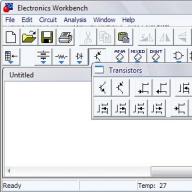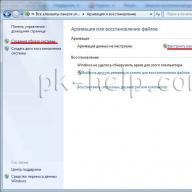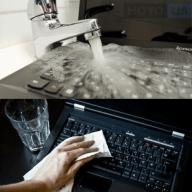A specialized graphic editor designed for the design of front and rear panels, nameplates and scales necessary for the manufacture of radio amateur devices, as well as for the repair of measuring and household equipment, various office equipment and vehicles.
FrontDesigner is an extremely easy-to-learn program with an intuitive interface. Each button in the utility has a tooltip. When creating a new layout, it is proposed to select the overall dimensions, background color and methods of filling the work area. The creation of the required appearance takes place using ready-made elements or by drawing them on their own. All elements of the library are grouped into thematic pages, the number of which reaches several dozen. You can add your own symbols to the library by creating new page sections. Also, when developing layouts, it is possible to import into the working field any picture or photo in the formats * .jpg, * .bmp, * .emf and * .wmf.
The working window of the editor can display a grid with square mesh sizes from 0.1 to 100 mm, and the size can be changed in 0.1 mm increments. The auxiliary working window performs a number of functions depending on the selected menu. For convenience, horizontal and vertical rulers with scale-dependent divisions are located at the edges of the working area. Metric and imperial scales are supported.

FrontDesigner contains tools for drawing circles (ovals), rectangles (polygons), sectors, arcs, lines, scales, labels, paths, and more. The program provides the ability to rotate project objects at any angle, as well as align them relative to each other and the edges horizontally and vertically. When you select any tool that draws lines or geometric shapes, it becomes possible to choose the thickness of the object outlines, their color, and also the type (dashed, dashed, invisible, etc.). The program contains built-in editors for creating various options for openings and scales (circular, straight, increasing, falling, polygonal, sinusoidal, linear, logarithmic).
FrontDesigner allows you to print ready-made drawings of layouts, and if necessary, further processing by other programs - to export them in graphic formats * .bmp, * .gif and * .emf. In addition, all holes, milling and engraving can be saved to a file with the * .plt extension (HPGL format) and used for plotting. When printing a project, there are a number of options that remove unnecessary information present in the layout (background, labels, frame, objects, holes, dimension lines). An adjustment mode is offered that allows you to fine-tune the conformity to the design of the linear dimensions of the imprint.
Among other things, FrontDesigner can be used in the production of posters and safety signs, drawings for user instructions and business cards. And the symbol library page called "Flowchart" is for creating program flowcharts. The English-language help file includes a number of very useful descriptions for making custom front panels (self-adhesive, engraved and drilled, laminated).

The latest version of FrontDesigner costs 39 euros. You can download the demo version at the link below. The possibilities of saving, printing and exporting results are blocked in it.
Through the efforts of domestic programmers, all versions of FrontDesigner that exist today have been cracked and translated into Russian (except for the "Help" section). However, the Russian-language version of the program contains many more bugs than the English-language version.
FrontDesigner editor was developed by the German company ABACOM, which is the author of such popular applications as. The company is located in the city of Ganderkesee in the Oldenburg region.
RUDIS - front panel simulatordownload (1075.9 kb.)
Available files (26):
| n1.hlp | |||
| n2.ini | |||
| n3.exe | |||
| n4.inf | |||
| n5.ini | |||
| n6.hlp | |||
| n7.lib | |||
| n8.lib | |||
| n9.lib | |||
| n10.lib | |||
| n11.lib | |||
| n12.lib | |||
| n13.lib | |||
| n14.lib | |||
| n15.lib | |||
| n16.lib | |||
| n17.lib | |||
| n18.lib | |||
| n19.lib | |||
| n20.lib | |||
| n21.lib | |||
| n22.lib | |||
| n23.doc | 692kb. | 14.05.2009 20:05 | download |
| n24.fpl | |||
| n25.inf | |||
| n26.ini |
- See also:
- Babakov M.F., Popov A.V. Machine Simulation Methods in Electronic Hardware Design (Document)
- Amelina M.A., Amelin S.A. Micro-Cap schematic simulation program. Versions 9, 10 (Document)
- Program - MicroFEM Version 4.10 (2011) (Program)
- Materials for the M25.50 / 01 series (Document)
- Sandwich Panel Design Guidelines (Document)
- Gell P.P., Ivanov-Esipovich N.K. Electronic Equipment Design (Document)
- Orlova I.V., Polovnikov V.A. Economic and Mathematical Methods and Models: Computer Simulation (Document)
- A program for modeling mechanisms as kinematic diagrams in real time (Program)
- Metal siding 1.2.0 (Document)
- Design and technological design of electronic equipment (Document)
- GKD 34.35.604-96. Maintenance of relay protection devices, emergency control equipment, electrical equipment (Document)
- USpice: Simulating Electronic Circuits (Document)
n23.doc
RUDIS - front panel simulatorV.M. Danysh (US5NGH), Yampol, Vinnytsia region
For radio amateurs who are engaged in the design of various equipment and who know how to use a personal computer, this article will be very useful.
The author of these lines has long been in search of a simple program for simulating the front panels of various electronic equipment. The search did not go unsuccessful - RUDIS is a very easy-to-use program for simulating the front (and other) panels of the equipment. The fact that "RUDIS" is Russified is also positive. Surprisingly, why has not it received distribution among radio amateurs-designers of the SIP countries until now. Maybe because it was not described in radio amateur magazines?
The program can be downloaded free of charge from the site www.ser-mo-44.ucoz.ru/load/1-1-0-9 in the "Miscellaneous" section. It does not require installation, just unpack the zip archive. The archive size is only 416 Kb.
The working window of the program is shown in Fig. 1. It consists of a main menu, a standard toolbar, left and right toolbars, and, of course, a working (drawing) sheet of the program. First, let's take a look at the main menu of the program.
File menu
New file - creating a file of the hardware panel;

Open - open the file of the working (drawing) sheet of the equipment panel;
Print - in an open new window you can choose to print normal or mirror-like, sheet background, frame, ruler, date and scale settings, as well as adjust the properties of the printer used (Fig. 2). Some printers may not print properly when connected. To solve this problem, there is a tool "Correction" - you need to enter the horizontal and vertical correction factors;
Close - close the program.

The Edit menu contains commands known to PC users from many other programs: Undo, Cut, Copy, Paste, Select All, Delete, and Duplicate (a combination of Copy and "Insert") to edit the working (drawing) sheet.
The "Layout" menu contains five tools for positioning elements of the working (drawing) sheet: "Position in front", "Position in back". "Group", "Ungroup", "Align", the names of which speak for themselves.
Menu "Library" - the ability to add (load) and create various symbols for location on the equipment panel (for the name of symbols, see the Right toolbar): "Add to library", "New page", "Delete page", "Rename page"
Options menu
Front panel - select the size of the front panel;
Grid (dimensions) - the ability to enable and select dimensions in millimeters of the grid of the working (drawing) sheet;
Start marker]
Scale builder - for potentiometers and other devices with the ability to build straight and round scales, select the height, the number of division segments (Fig. 3).
Menu "?" contains help in German and version information.
On the Standard toolbar, which is located below the Main menu of the program, the main commands from it are duplicated, and there are also three new tools: "Display (vertical)", "Display (horiz.)", "B / W Color on / off ". The first two display the elements of the working (drawing) sheet selected with the left mouse button in vertical and horizontal views, respectively. The last tool allows you to make a working (drawing) sheet of the equipment panel in black and white.
The left toolbar is shown in Fig. 4.
and contains 12 style elements for the worksheet:
Select, Edit, Scroll, Replace;
Rotate - change the angle of rotation of an element (object) of the working (drawing) sheet by clicking on it with the left mouse button;
Magnifier - use the right mouse button to increase the viewing scale, with the left button to decrease;
Drawing lines. Convenience lies in the fact that when drawing (not only lines), coordinate lines for the location of the pencil appear, and in the lower left corner of the program window, the point of its location along the abscissa (x) and ordinate (y) axes (Fig. 5);
Drawing rectangles. With the first left-click, we define the beginning of the rectangle, the second
by pressing - the end of the rectangle;
Drawing a circle is similar to drawing rectangles;
Drawing polyhedra. The first press of the left mouse button determines the beginning of the polyhedron, the second and subsequent clicks - each corner of the polyhedron, by pressing the right mouse button - the completion of the construction of the polyhedron;

Drawing an arc. By first pressing the left mouse button, define the radius of the arc, the second - the beginning of the arc, the third - its end;
Panel inscriptions. First, by pressing the left mouse button, we determine the location of the inscription. In the open new window, enter the text of the inscription, the height in millimeters and the type of font, the angle of the inscription in degrees (Fig. B);

Holes. By clicking on the left mouse button, we determine the location of the planned hole. In the open new window, enter the hole diameter;
Scale-builder - duplication of an instrument from the main menu of the program, see above;
Dimensioning is a useful tool that allows you to set clear drawing dimensions from point to point. By first pressing the left mouse button, we define the beginning of the ruler, the second pressing - the end of the ruler, and the third - the distance of the ruler with arrows to the element (object), the dimensions of which are measured (Fig. 7).

The right toolbar is shown in Fig. 8. It includes four tabs:
Symbol - Adds a symbol to a worksheet in the form of a picture or an icon, which are grouped into 16 subgroups depending on the application:
"Plates", "Lamps", "Buttons", "Connectors", "Sockets", "Pointers", "Mechanics",
"Batteries", "Nameplates", "Audio", "Video", "Auto Symbols", "Climate", "Icons", "LEDs", "Signals". In fig. 8 shows a subgroup "Audio", which contains nine icons;
Pen - select the pen and color of the outline;
Fill - selection of the shading color for various areas of the equipment panel;
View - a preview of the hardware panel.
The working (drawing) sheet of the program has vertical and horizontal rulers with millimeter scales.
Let's look at a quick example of how to create a hardware front panel:
1. Open the program and execute the command File> New File. In the window that opens, select the size of the working (drawing) sheet.
2.Using the Left Toolbar
we draw lines, rectangles, circles, inscriptions, etc. on the working (drawing) sheet.
3. From the "Symbol" tab of the Right toolbar, insert pictures or icons onto the working (drawing) sheet.
4. Using the "Pen" and "Fill" tabs of the Right toolbar, select the pen, outline colors and shading colors of individual areas of the working (drawing) sheet, respectively.
5. Thanks to the "Magnifier" tool of the Left Toolbar, we preview the drawing of the front panel at the desired scale using the right and left mouse buttons.
6. We execute the command File> Print. In the open print window, select the print parameters.
7. Save the drawing of the equipment panel using the File> Save As command as a file in a convenient place for you.
8. Command File> Close - exit the program.
Design for health!
With FrontDesigner 3.0, users can draw the front panels of the enclosures. The utility is in Russian, which makes it easier to use.
Functionality of the program
The utility will become an indispensable assistant for radio amateurs. The program includes a wide range of components: holes, handles, various elements and graduations. FrontDesigner 3.0 comes with a default set of components with different holes and decals. Large picture panels are created using drag and drop. Users can also create their own templates and include their work in the library. The main task of the program is to design the rear and front panels during the production of amateur radio devices.
Control panel elements
The utility includes a wide range of tools, where there is a hint above each item. An intuitive interface speeds up the learning process. To insert the desired component, simply select the appropriate element from the library. All details are grouped by subject area, which makes the search process easier. During image development, you will be able to import photos and drawings in common formats: emf, wmf, bmp and jpg. Users can also print ready-made drawings and layouts.
Advantages
- users can also create their own templates;
- drawing the front and back panels of the enclosures is carried out using the drag-and-drop method;
- the utility includes a wide range of tools;
- all details are grouped according to thematic areas;
- the utility is fully compatible with all versions of Windows.
Front Designer is a popular front-panel design for amateur radio devices.
Good day, dear radio amateurs!
Welcome to the site ““
In this article, we will look at front panel editing software popular among radio amateurs - Front Designer.
Program Front Designer is intended for creating and editing the front panels of homemade radio amateur devices. The program is fully translated into Russian (except for the “Help” section) and is very easy to use. You can download the program in the "Technologies" section or follow the link below:
By experimenting with the buttons, you will understand what each of them is for and how to work with them:

At the beginning of work, it is necessary to set the dimensions of the front panel in millimeters (bottom panel). Then decide on the size of the mesh. We set the size of the grid (top main panel, service, grid properties) according to our smallest size (I use distances up to 0.5 cm). Next, I marked all the holes (for variable resistances, connectors, switch, LED and windows for voltmeters):

After that, using the ready-made library and the elements I created, to the best of my design abilities, I “paint” the front panel:

This is the kind of "beauty" I got (:-D). After that, I go into print mode (file, print with preview) and check (or remove) the checkboxes I need and print the resulting picture:

What to print on (thick sheet of paper, self-adhesive film, ...) largely depends on what kind of printer you have (black and white, color, laser, inkjet). After that, carefully cut out the holes (especially for voltmeters), glue our workpiece (so that the drawing is not overwritten, you can glue a transparent self-adhesive film on top or varnish it), put all the details in place and enjoy the result. I recommend that you first make the front panel on a sheet of standard paper and cut out all the holes to make sure they are compatible with the workpiece on which you will stick it (real holes in the workpiece may not match the picture). If there are any discrepancies, we clarify them and repeat the experiment until the desired result is obtained.
Front Panel Designer is a program for designing dummy panels for devices.
- the program is designed for drawing the front panels of the device cases using a computer. The program interface is simple and easy to use.

If you are a radio amateur, you will quickly understand the advantages of "computer" drawing of panels and appreciate this program at its true worth. Various knobs, holes, graduation scales, and more can be done in it. The distribution kit with the program has templates for various inscriptions and holes, with which you can create large panels by simply dragging and dropping the mouse without drawing the same part every time. You can add your own templates to the library of templates.

Key features:
Design Exactly What You Want
Cost effective prototypes and production runs:
Our design software coupled with modern CNC milling technology allows cost-effective, customized, and accurate manufacturing.
Free CAD Program:
With just a couple of clicks you can place multiple features directly onto your project, for example, drilled holes, rectangular cut-outs, cavities, colored engravings, etc.
Front Panel Designer provides what is needed to easily create custom-designed front panels and enclosures.
Accuracy:
Design your project down to the last tenth of a millimeter. Instead of inaccurate results from files and drills, you get precise results.
Integrated ordering program:
Convenient ordering. Finish your design and place your order directly from Front Panel Designer. No e-mails, no conversions, no uploads, ..., no hassles.
Real time cost-updates:
Stay in control of your costs. Watch the immediate cost adjustment throughout the entire design process.

Title: Front Panel Designer
Year of issue: 2015
Version: Express 4.4.2
System Requirements
IBM or compatible Pentium / AMD processor (900 MHz or greater), 512 MB RAM or greater. 1024 x 768, 16-bit display (32-bit recommended)
Windows XP
Windows Vista all SP
Windows 7
Language English
File size 10.4 mb




